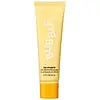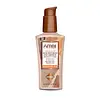What's inside
What's inside
 Key Ingredients
Key Ingredients

 Benefits
Benefits

 Concerns
Concerns

No concerns
 Ingredients Side-by-side
Ingredients Side-by-side

Zinc Oxide 12%
Cosmetic ColorantWater
Skin ConditioningIsoamyl Laurate
EmollientGlycerin
HumectantCaprylic/Capric Triglyceride
MaskingButyloctyl Salicylate
Skin ConditioningPolyglyceryl-10 Stearate
Skin ConditioningPoly C10-30 Alkyl Acrylate
Emulsion StabilisingPolyhydroxystearic Acid
EmulsifyingCetearyl Olivate
Sorbitan Olivate
EmulsifyingRubus Idaeus Seed Oil
EmollientPanax Ginseng Root Extract
EmollientTheobroma Cacao Seed Extract
AntioxidantHydroxyethyl Acrylate/Sodium Acryloyldimethyl Taurate Copolymer
Emulsion StabilisingHydroxyacetophenone
AntioxidantPolyglyceryl-10 Laurate
Skin ConditioningMicrocrystalline Cellulose
AbsorbentButylene Glycol
HumectantXanthan Gum
EmulsifyingCellulose Gum
Emulsion StabilisingPhenoxyethanol
PreservativeZinc Oxide 12%, Water, Isoamyl Laurate, Glycerin, Caprylic/Capric Triglyceride, Butyloctyl Salicylate, Polyglyceryl-10 Stearate, Poly C10-30 Alkyl Acrylate, Polyhydroxystearic Acid, Cetearyl Olivate, Sorbitan Olivate, Rubus Idaeus Seed Oil, Panax Ginseng Root Extract, Theobroma Cacao Seed Extract, Hydroxyethyl Acrylate/Sodium Acryloyldimethyl Taurate Copolymer, Hydroxyacetophenone, Polyglyceryl-10 Laurate, Microcrystalline Cellulose, Butylene Glycol, Xanthan Gum, Cellulose Gum, Phenoxyethanol
Acrylates Copolymer
Aloe Barbadensis Leaf Juice
Skin ConditioningWater
Skin ConditioningArctostaphylos Uva Ursi Leaf Extract
Skin ConditioningAscorbyl Palmitate
AntioxidantButyloctyl Salicylate
Skin ConditioningC12-15 Alkyl Benzoate
AntimicrobialCamellia Sinensis Extract
AntioxidantCaprylic/Capric Triglyceride
MaskingCetearyl Alcohol
EmollientCetearyl Glucoside
EmulsifyingCetyl Alcohol
EmollientCucumis Sativus Extract
Skin ConditioningCyclopentasiloxane
EmollientCyclotetrasiloxane
EmollientDimethicone
EmollientEthylhexylglycerin
Skin ConditioningGlycerin
HumectantGlyceryl Stearate
EmollientGlycyrrhiza Glabra Root Extract
BleachingHelianthus Annuus Flower
Skin ConditioningHyaluronic Acid
HumectantMagnesium Aluminum Silicate
AbsorbentPhenoxyethanol
PreservativePolysorbate 20
EmulsifyingSaccharide Isomerate
HumectantSilica
AbrasiveSodium Hydroxide
BufferingStearyl Alcohol
EmollientTocopheryl Acetate
AntioxidantAcrylates Copolymer, Aloe Barbadensis Leaf Juice, Water, Arctostaphylos Uva Ursi Leaf Extract, Ascorbyl Palmitate, Butyloctyl Salicylate, C12-15 Alkyl Benzoate, Camellia Sinensis Extract, Caprylic/Capric Triglyceride, Cetearyl Alcohol, Cetearyl Glucoside, Cetyl Alcohol, Cucumis Sativus Extract, Cyclopentasiloxane, Cyclotetrasiloxane, Dimethicone, Ethylhexylglycerin, Glycerin, Glyceryl Stearate, Glycyrrhiza Glabra Root Extract, Helianthus Annuus Flower, Hyaluronic Acid, Magnesium Aluminum Silicate, Phenoxyethanol, Polysorbate 20, Saccharide Isomerate, Silica, Sodium Hydroxide, Stearyl Alcohol, Tocopheryl Acetate
 Reviews
Reviews

Ingredients Explained
These ingredients are found in both products.
Ingredients higher up in an ingredient list are typically present in a larger amount.
Butyloctyl Salicylate is a chemical UV filter structurally similar to octisalate. It is a photostabilizer, SPF booster, emollient and solvent. This ingredient helps evenly spread out ingredients.
According to a manufacturer, it is suitable for pairing with micro Titanium Dioxide, Zinc Oxide, and pigments.
Photostabilizers help stabilize UV-filters and prevents them from degrading quickly.
Learn more about Butyloctyl SalicylateThis ingredient is an emollient, solvent, and texture enhancer. It is considered a skin-softener by helping the skin prevent moisture loss.
It helps thicken a product's formula and makes it easier to spread by dissolving clumping compounds.
Caprylic Triglyceride is made by combining glycerin with coconut oil, forming a clear liquid.
While there is an assumption Caprylic Triglyceride can clog pores due to it being derived from coconut oil, there is no research supporting this.
Learn more about Caprylic/Capric TriglycerideGlycerin is already naturally found in your skin. It helps moisturize and protect your skin.
A study from 2016 found glycerin to be more effective as a humectant than AHAs and hyaluronic acid.
As a humectant, it helps the skin stay hydrated by pulling moisture to your skin. The low molecular weight of glycerin allows it to pull moisture into the deeper layers of your skin.
Hydrated skin improves your skin barrier; Your skin barrier helps protect against irritants and bacteria.
Glycerin has also been found to have antimicrobial and antiviral properties. Due to these properties, glycerin is often used in wound and burn treatments.
In cosmetics, glycerin is usually derived from plants such as soybean or palm. However, it can also be sourced from animals, such as tallow or animal fat.
This ingredient is organic, colorless, odorless, and non-toxic.
Glycerin is the name for this ingredient in American English. British English uses Glycerol/Glycerine.
Learn more about GlycerinPhenoxyethanol is a preservative that has germicide, antimicrobial, and aromatic properties. Studies show that phenoxyethanol can prevent microbial growth. By itself, it has a scent that is similar to that of a rose.
It's often used in formulations along with Caprylyl Glycol to preserve the shelf life of products.
Water. It's the most common cosmetic ingredient of all. You'll usually see it at the top of ingredient lists, meaning that it makes up the largest part of the product.
So why is it so popular? Water most often acts as a solvent - this means that it helps dissolve other ingredients into the formulation.
You'll also recognize water as that liquid we all need to stay alive. If you see this, drink a glass of water. Stay hydrated!
Learn more about Water